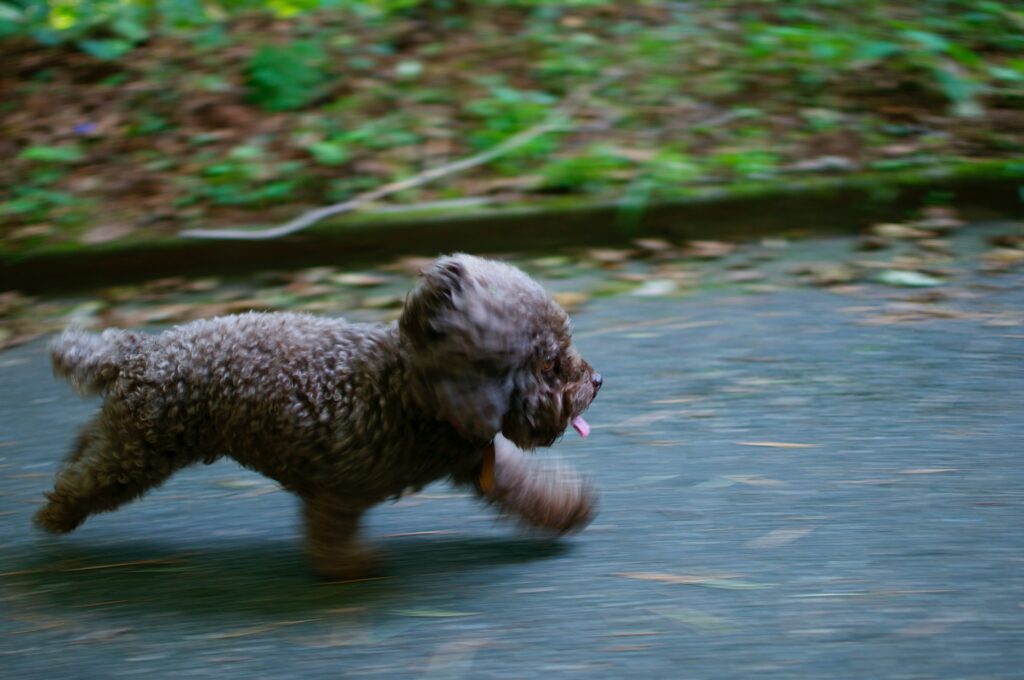Choosing a Dog Breed: Fashion VS Dog Needs
By Dorothée Pâris Pasturel • 10 December 2024
In recent years, certain dog breeds have been all the rage with adopters: the Australian Shepherd, the Border Collie, the Husky and Doodle-type crosses are the public’s favorites. But is it really a good idea to choose a Doodle when you don’t know all of its characteristics or an Australian Shepherd when you’re not a very active person? For you, we detail here the profile of these trendy breeds and give you several tips on how to choose a breed that suits YOU.
The Truth About Doodles
Origin and genetics
The term “doodle” comes from the English term “poodle” which means poodle. The first thing to know is that doodle-type dogs are not recognized as a breed by the CKC (Canadian Kennel Club) or other authorized organizations. These dogs are the result of a hybrid cross between a poodle and another breed. Examples: golden retriever x poodle (goldendoodle), labrador x poodle (labradoodle), yorkshire x toy poodle (yorkipoo) etc. These crosses were created following a desire to create a hypoallergenic dog. It was Wally Conron who, following the request of a blind lady living in Hawaii, created a hybrid dog (the labradoodle). This lady wanted to have a hypoallergenic dog because her husband was allergic. The goal was to produce an ideal dog combining the woolly hair of the poodle and the character of the labrador. However, genetics is much more complex and cannot be summarized in this way, which can lead to surprises in the behavior and even the appearance of these dogs. Let us also remember that NO dog is 100% hypoallergenic.

In short, it is essential to bring him down from his pedestal: the doodle is not an exceptional dog but rather an individual who can have health problems and behavioral imperfections. Wally Conron also considers his crossbreeding as “the biggest regret of his life.” Read the article here .
Backyard Breeders
The second thing to know is that the vast majority of doodles do not come from serious breeders for whom animal welfare is at the heart of decisions. There is therefore no standard for breeding the breed since it is not even recognized as such yet. This results in “goody bag” dogs in terms of size, hair type, temperament and health. Dogs without papers rarely come with medical tests. The doodle fashion thus contributes to puppy mills and garage breeders who only think of their financial interests by selling their puppies for a fortune to poorly informed customers. Be careful: to avoid being tricked, ask the breeder questions: who are the parents of the puppies (ask to see them), have they had health exams (ask to see the papers), where are they raised and bred (ask to see the premises), how many litters per year does the mother have (if it’s more than 2 or 3, run away). If the breeder only partially answers your questions or refuses to show you around, walk away!
Read also:
3 Essential Things to Know About Dogs and Puppies for Sale or Giveaway
Hot Topic of the Hour: Doodle Dogs
These active dogs that we love so much
They are called “the Ferraris of the dog world.” We turn around to look at them in the street because their beauty attracts us so much. And, as with everything that is beautiful, humans tend to want to make it their own. Who could resist the beautiful blue eyes of a husky or the dense and colorful fur of an Australian shepherd? Yes, but under the beautiful body of a Ferrari hides a powerful and demanding engine. This is the downside that comes with such a dog: its inexhaustible energy.
Origin and education
Putting forward the famous principle of “it depends on their education” we too often forget that the fundamental characteristics of a dog come first from its genetics. From this observation, we must remember that, for example, sheepdogs (border collies or Australian shepherds for example) have been bred for generations for their herding instinct and stimulation by movement, in order to guard herds of livestock. These are generally dogs that can easily work all day on a farm.

It is therefore highly discouraged to adopt this type of dog if our lifestyle is rather sedentary. Shepherd-type dogs MUST do a lot of physical activity DAILY (2 to 4 hours per day). Instead, behavioral problems can develop (anxiety, destruction of furniture, OCD, reactivity, aggressiveness, etc.) The Siberian Husky , on the other hand, is a working breed made to pull the weight of a sled in the snow at winter temperatures for long hours. In other words, these are dogs with exceptional physical endurance. They ABSOLUTELY must exert themselves physically every day to feel good (2 to 4 hours per day). And we’re not talking about simply throwing a ball in the yard, we’re talking about hiking, agility courses, canicross, etc.

In addition, huskies are not really made for obedience. So you have to keep in mind that it is normal to put more effort and creativity into getting a husky to be interested in you and do what you want him to do! All of this, of course, while respecting the principle of positive reinforcement and collaboration (forget the outdated notions of pack leader or other such nonsense). If you were thinking of adopting a husky while you live in an apartment and you only plan to walk him for 20 minutes twice a day while imagining that he will be calm and will not pull on the leash, move on! Coco will drive you crazy 😉
Read also:
https://www.demaindemaitre.ca/husky-dressage-comportement-caractere/
The importance of mental stimulation
Although physical activity is essential, we must not forget the importance of mental stimulation in dogs, especially shepherd dogs. It is just as necessary for their well-being as physical activity. 10 minutes of mental stimulation is equivalent to 1 hour of physical activity, so it would be a shame to deprive yourself of it! Of course, it does not replace exercise but is a great complement to satisfy canine needs. So, use your imagination to make your dog work and think : enrichment bowls, chew toys, interactive toys , learning tricks (sit, lie down, roll, turn around the leg, play dead, etc.). Odor detection activities are also very stimulating and important for your dog: looking for treats hidden in the house or garden, looking for buried toys, etc. And of course: let your dog smell the odors during his walk. In addition to being fun for him, this represents a lot of olfactory and mental stimulation.
In total, a shepherd or husky type dog should be able to do 5 hours of daily activities (physical, mental, olfactory, chewing, etc.).

What questions should you ask yourself before adopting a dog?
a. Why do I want a dog? For what activities?
- I want a dog for affection and lots of cuddles: the husky or breeds identified as independent, however beautiful they may be, are not for you. Yes, a strong bond can be created between you and your dog, but he will not be a fan of big attentions or evenings glued together on the couch.
- I want a dog to do sports activities very regularly, I can’t sit still and I would like to have a companion during my outings: shepherds, jack Russells and huskies are a very good choice! It’s a safe bet that you will get tired before them but at least you will speak the same language: sport.
b. Why would one race be better than another?
No breed can guarantee that the dog you choose will be perfect or ideal for you. You will surely have to work on certain things with him, because, like any living being, he will have flaws. It would be better to look at it like this: which breed fits my lifestyle and my daily life ?
- I have very young children : so a big excited dog that jumps everywhere is definitely not a good idea. He could inadvertently hurt them. Instead, choose a small or medium-sized dog that has been socialized from a young age with children (with good experiences of course!).
Check out this article on Choosing the Perfect Dog Breed for Your Kids .
- I live in an apartment , so a dog that tends to bark at the slightest noise is probably not the best choice.
Check out this article on Breeds that bark little
c. How many hours a day can I spend with my dog?
If you are often away from home, do not choose a dog with many needs or who tends to develop anxiety when left alone. For example, generally avoid adopting a puppy if you work in an office 7 hours a day. He will need to learn cleanliness and have regular outings and interactions to develop his socialization .
d. What are the possible health problems of a breed?
Again, if you choose a particular breed, you should know that it often comes with its share of surprises in terms of medicine. Large dogs such as Bernese Mountain Dogs are known to have hip problems as they age (dysplasia, ortolani, etc.). Dogs with long ears tend to develop ear infections. Small dogs, on the other hand, often have orthopedic and oral problems. Each breed has its share of small weaknesses, so take the time to find out from your veterinarian in order to be well prepared for the future. In conclusion , ask yourself the right questions before adopting a dog or before choosing a breed. Find out about the dog’s behavior and imagine your life with him. Don’t be afraid to set your own limits. It’s okay not to be a sports fanatic and to prefer watching Netflix with popcorn, but don’t impose on your dog a lifestyle that is not made for him.
Read also:
5 Steps to Choosing the Perfect Dog Breed for You & Your Family!

>> Are you hesitant to adopt a dog or choose a breed? Ask professionals from the canine world. At Proanima, we will be happy to help you. Contact us: 450-655-2525 / info@proanima.com
>> Would you like to know the instincts and skills of each breed? Here are several videos that may enlighten you: Greyhound racing: https://www.youtube.com/watch?v=PXnK906Jqa0 Labrador diving: https://www.youtube.com/watch?v=U3OONLOKtzE Obedience course: https://www.youtube.com/watch?v=I3EGu5-o9B4 Adult border collie rounding up: https://www.youtube.com/watch?v=tDQw21ntR64 Puppy border collie rounding up: https://www.youtube.com/watch?v=as73mxFj1nc A beagle looking for a squirrel: https://www.youtube.com/watch?v=QUtFsZG5-LU Huskies pulling a sled: https://www.youtube.com/watch?v=9egC065_wzo Fixing and hunting: https://www.youtube.com/watch?v=HpvdhPij4EI Malinois puppies biting: https://www.youtube.com/watch?v=km7fl6CMAJM





Leave a Reply